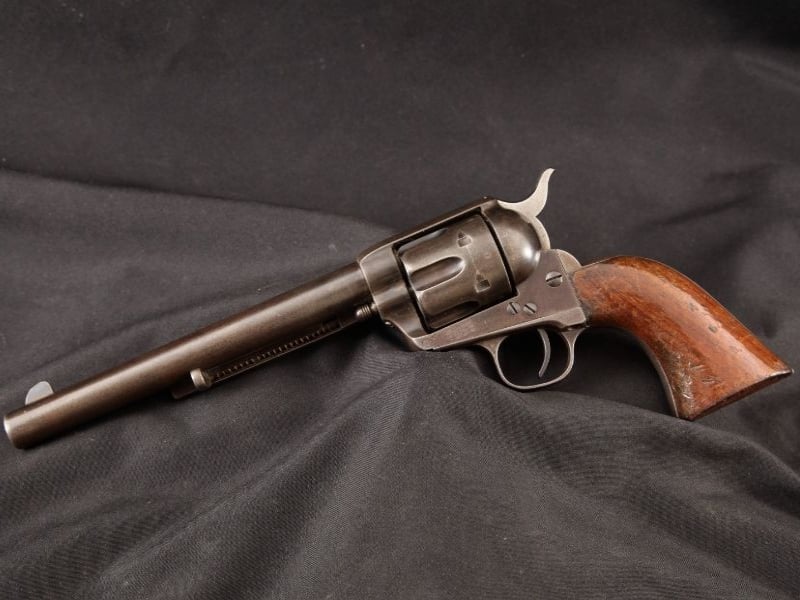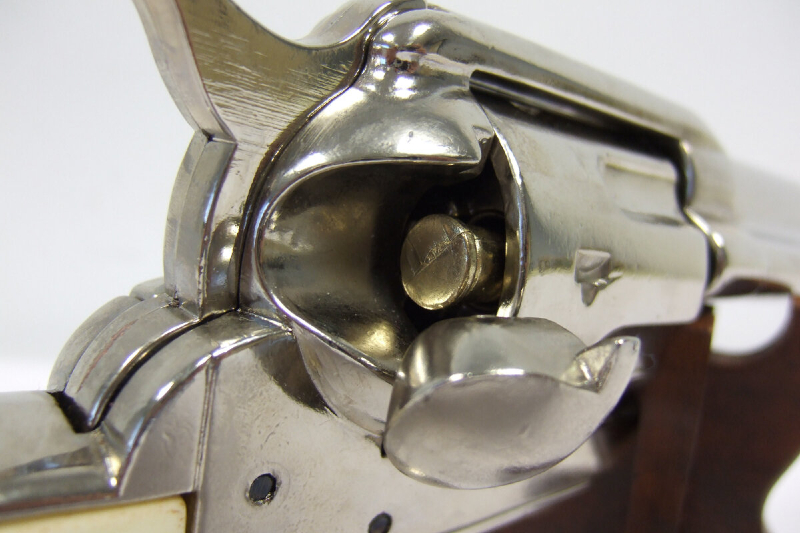It was 1835 when Samuel Colt designed what is now known as the first modern revolver, and 1836 when his patent was approved. The result was the Paterson revolver, a gun with a cylinder that rotated on its own rather than needing to be turned manually. Colt said he came up with the design while on a ship at sea, and although there are some conflicting accounts of exactly how he got the idea, the results are undeniably fantastic. It would be another four decades before the Colt 1873 Single Action Army revolver would be created, and the man behind that gun wasn’t Colt himself.

1873 SAA Design
A few things delayed the creation of the gun that would become known as the 1873 SAA (Single Action Army) . Chief among them was a patent belonging to Rollin White, the gunsmith who figured out how to make bored-through chambers work on revolvers. White’s design allowed cartridges to be loaded from the rear of the cylinder. Interestingly, White worked for Colt prior to patenting his design. Colt didn’t see eye to eye with White, so the inventor left. Of course, the bored-through method White patented didn’t really work. In fact, there was only a single prototype made, and it failed rather dramatically.

Despite the failure of that early design, the concept itself was sound. Smith & Wesson convinced White to grant them the right to use his patent and proceeded to fine-tune it into something workable. The Smith & Wesson Model 1 was the first gun they produced and also the first successful rimfire revolver to be made on a commercial level.
On April 4, 1869, White’s patent expired and the concept was fair game for Colt. The manufacturer put designers William Mason and Charles Brinckerhoff Richards on the task based on the past successes of the two men. Before they could get to work on their own bored-through cylinder design, the engineers tried out methods that resulted in the 1871-72 Open Top, which was chambered in 44 Henry, a rimfire round. This ended up coinciding with the 1872 United States government revolver trials, a time during which they were looking for a new service weapon.

There’s not a lot of documentation of the revolver trials that resulted in what is arguably the most iconic revolver design ever. What is known is that while the trials for the gun were taking place, Colt and the Union Metallic Cartridge company were also working on a new cartridge. The cartridge in question was the 45 Colt, and in the end, the United States army accepted both the 45 Colt and what would become the 1873 SAA revolver. The gun was also called the “New Model Army Metallic Cartridge Revolving Pistol.”
The 1873 Single Action Army revolver chambered in 45 Colt replaced the Colt 1860 Army Percussion Revolver, which was a 44 caliber cap and ball with a rebated cylinder. It took no time at all for the 1873 SAA to become more popular than the Smith & Wesson Model 1.
Specifications
There were and are some great advancements in firearms technology evident in the 1873 SAA. As its name suggests, it was a single-action only revolver. The first generation of the gun was offered with different barrel lengths such as the “Civilian/Gunfighter” 4 ¾ inch barrel, “Artillery” 5 ½ inch barrel, and “Cavalry” 7 ½ inch barrel. A snubby model with a 4 inch barrel was also released and sometimes referred to as the “Sheriff’s Model.”

1873 Single Action Army Revolver Features
- Single-action only
- Cylinder doesn’t swing out but revolves in place for loading, firing, and unloading
- Wide range of barrel lengths
- Fixed blade front sight
- 6 shot cylinder
Various changes to the revolver took place over the years, including:
- A 44 Henry chambered model in 1875
- A “Flattop Target Model” that had an adjustable leaf rear sight
- Cylinder pin retaining screw replaced with spring-loaded pin in 1896
- Sights with a more visible profile in 1920
- Available in 30 different calibers
- Most popular first generation chamberings included 45 Colt, 44 Winchester Center Fire, 38 Winchester Center Fire, and 41 Colt
- Launch of the Colt Bisley model target pistol in 1894
- Creation of the Colt Buntline model, originally made popular by Wyatt Earp’s tall tales, became reality in 1957
- Transfer bar safety introduced with the Colt Cowboy

Modern 1873 SAA Models
Today there are a number of reproductions of the 1873 SAA being made by various gun makers. Some of the better-known manufacturers in the market are Uberti, Pietta, and Traditions Firearms. It’s worth mentioning that different companies approach reproduction models in varying ways, so those guns may or may not include features that are different from the original 1873 SAA design. For example, Ruger’s 1873 SAA revolvers are modernized a bit more than many other designs.
Although modern versions of the old 1873 SAA are clearly not the same as owning an original, they have a lot to recommend them. Not only are they frequently affordably priced but they give you, as a gun owner, exposure and experience with a platform you might not otherwise try. Learning to use this type of handgun is a great way to broaden your shooting skills and ensure you’re able to run one should the need—or desire—ever arise.
Traditions Firearms Models
- Buntline Model in 45 Colt with 12 inch barrel
- Bill Tilghman Model in 45 Colt or 357 Magnum with 4.75 inch barrel
- Frontier series in 357 Magnum with 3.5 inch barrel
- Frontier series in 357 Magnum with 5.5 inch barrel

Uberti Models
- Cavalry Model in 45 Colt with 4.75, 5.5, or 7.5 inch barrel
- Cody Model in 45 Colt with 4.75 inch barrel
- Hombre Model in 45 Colt or 357 Magnum with 4.75 inch barrel
- Callahan Model in 44 Magnum with 6.5 inch barrel
- From Uberti regarding their Cattleman line of 1873 SAA revolvers:
“In 1873, Colt’s single-action Army (SAA) revolver became the Army’s standard sidearm. Cavalry troopers were armed with the new revolvers. Lawmen and outlaws alike were quick to adopt the handy new 6-shooter which earned the nickname “Peacemaker.”
The single-action Army was most widely produced with a color case-hardened frame and blued barrel. Meanwhile, a nickel-plated version was issued to Indian scouts. And a bright charcoal blue finish was available from the factory. But with years of use, the old 6-guns took on a well-handled soft gray patina. All of these classic finishes are available in the 1873 Cattleman.”
Common reproduction chamberings
- 45 Colt
- 357 Magnum
- 44 Magnum
1873 SAA Uses
These revolvers are used for a number of things such as cowboy action shooting and hunting small game and varmints. They’re also excellent for spending time at the range shooting targets. If you’re lucky enough to have an old, collectible model, consider spending time running the gun rather than consigning it to be a safe queen. At least shoot it a little.
It can be fun learning about different platforms. Do you own an 1873 SAA? Tell us about it in the comments section.


